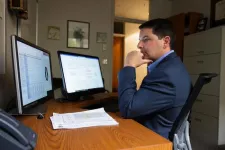(Press-News.org) Acoustic resonators are everywhere. In fact, there is a good chance you’re holding one in your hand right now. Most smart phones today use bulk acoustic resonators as radio frequency filters to filter out noise that could degrade a signal. These filters are also used in most Wi-Fi and GPS systems.
Acoustic resonators are more stable than their electrical counterparts, but they can degrade over time. There is currently no easy way to actively monitor and analyze the degradation of the material quality of these widely used devices.
Now, researchers at the Harvard John A. Paulson School of Engineering and Applied Sciences (SEAS), in collaboration with researchers at the OxideMEMS Lab at Purdue University, have developed a system that uses atomic vacancies in silicon carbide to measure the stability and quality of acoustic resonators. What’s more, these vacancies could also be used for acoustically-controlled quantum information processing, providing a new way to manipulate quantum states embedded in this commonly-used material.
“Silicon carbide, which is the host for both the quantum reporters and the acoustic resonator probe, is a readily available commercial semiconductor that can be used at room temperature,” said Evelyn Hu, the Tarr-Coyne Professor of Applied Physics and of Electrical Engineering and the Robin Li and Melissa Ma Professor of Arts and Sciences, and senior author of the paper. “As an acoustic resonator probe, this technique in silicon carbide could be used in monitoring the performance of accelerometers, gyroscopes and clocks over their lifetime and, in a quantum scheme, has potential for hybrid quantum memories and quantum networking.”
The research was published in Nature Electronics.
A look inside acoustic resonators
Silicon carbide is a common material for microelectromechanical systems (MEMS), which includes bulk acoustic resonators.
“Wafer-scale manufacturable silicon carbide resonators in particular are known to have the best-in-class performance for quality factor,” said Sunil Bhave, professor at the Elmore Family School of Electrical and Computer Engineering at Purdue and co-author of the paper. “But crystal growth defects such as dislocations and grain boundaries as well as resonator manufacturing defects such as roughness, tether stress, and micro-scale craters can cause stress-concentrations regions inside the MEMS resonator.”
Today, the only way to see what’s happening inside an acoustic resonator without destroying it is with super powerful and very expensive x-rays, such as the broad-spectral x-ray beam at the Argonne National Lab.
“These types of expensive and difficult-to-access machines are not deployable for doing measurements or characterization in a foundry or somewhere where you’d actually be making or deploying these devices,” said Jonathan Dietz, graduate student at SEAS and co-first author of the paper. “Our motivation was to try to develop an approach that would allow us to monitor the acoustic energy inside of a bulk acoustic resonator so you can then take those results and feed them back into the design and fabrication process.”
Silicon carbide commonly hosts naturally occurring defects in which an atom is removed from the crystal lattice, creating a spatially local electronic state whose spin can interact with sound waves through material strain, such as the strain generated by an acoustic resonator.
When acoustic waves move through the material, they put mechanical strain on the lattice, which can flip the spin of the defect. Changes in the spin state can be observed by shining a laser through the material to see how many defects are “on” or “off” after perturbing them.
“How dim or how bright the light indicates how strong the acoustic energy is in the local environment where the defect is,” said Aaron Day, a graduate student at SEAS and co-author of the paper. “Because these defects are the size of single atoms, the information they give you is very local and, as a result, you can actually map out the acoustic waves inside the device in this non-destructive way.”
That map can point to where and how the system may be degrading or not operating optimally.
Acoustic control
Those same defects in silicon carbide can also be qubits within a quantum system.
Today, many quantum technologies build on the coherence of spins: how long spins will remain in a particular state. That coherence is often controlled with a magnetic field.
But with their technique, Hu and her team demonstrated that they could control spin by mechanically deforming the material with acoustic waves, obtaining a quality of control similar to other approaches using alternating magnetic fields.
“To use the natural mechanical properties of a material — its strain — expands the range of material control that we have,” said Hu. “When we deform the material, we find that we can also control the coherence of spin and we can get that information just by launching an acoustic wave through the material. It provides an important new handle on an intrinsic property of a material that we can use to control the quantum state embedded within that material.”
The research was co-authored by Boyang Jiang. It was supported by the National Science Foundation under the RAISE-TAQS Award 1839164 and grant DMR-1231319.
END
Using sound to test devices, control qubits
Control of atomic vacancies with sound waves could improve communications and offer new control for quantum computing
2023-10-25
ELSE PRESS RELEASES FROM THIS DATE:
Oregon State researchers uncover mechanism for treating dangerous liver condition
2023-10-25
CORVALLIS, Ore. – A study spearheaded by Oregon State University has shown why certain polyunsaturated fatty acids work to combat a dangerous liver condition, opening a new avenue of drug research for a disease that currently has no FDA-approved medications.
Scientists led by Oregon State’s Natalia Shulzhenko, Andrey Morgun and Donald Jump used a technique known as multi-omic network analysis to identify the mechanism through which dietary omega 3 supplements alleviated nonalcoholic steatohepatitis, usually abbreviated to NASH.
The mechanism involves ...
More than just carbs: starchy vegetables play an integral role in meeting nutrition needs
2023-10-25
A perspective recently published in Frontiers in Nutrition underscores the unique role starchy vegetables play as a vital vehicle for essential nutrients. The Dietary Guidelines for Americans currently recommend that most adults consume five to six cups (or cup equivalents) of starchy vegetables each week to help meet their total vegetable goals.1 Yet, as confusion around “good versus bad carbs” persists among consumers, there is a risk of starchy vegetable avoidance in favor of other carbohydrate foods perceived as ...
Study suggests that having common ancestors can jeopardize fertility for generations
2023-10-25
When it comes to the architecture of the human genome, it’s only a matter of time before harmful genes — genes that could compromise future generations — arise in a population. These mutations accumulate in the gene pool, primarily affected by a population’s size and practices like marrying within a small community, according to researchers.
But much of the information about the effects of a population’s mutation load is based on genetic theory, with limited direct evidence concerning the effects on evolutionary fitness, or fertility.
New research from University ...
Zooming in on our brains on Zoom
2023-10-25
New Haven, Conn. — When Yale neuroscientist Joy Hirsch used sophisticated imaging tools to track in real time the brain activity of two people engaged in conversation, she discovered an intricate choreography of neural activity in areas of the brain that govern social interactions. When she performed similar experiments with two people talking on Zoom, the ubiquitous video conferencing platform, she observed a much different neurological landscape.
Neural signaling during online exchanges was substantially suppressed compared to activity observed ...
Breaking down the bias: the portrayals of women in medicine in films
2023-10-25
In the 2009 film "Gifted Hands," based on a true story, the audience follows Black neurosurgeon Dr. Ben Carson as he successfully performs three risky surgeries, earning praise from the media and medical community. This movie was not only a hit with critics and audiences, but it also inspired Bismarck Christian Odei, MD, an assistant professor in radiation oncology at Huntsman Cancer Institute at the University of Utah, to follow his passion.
“Seeing a physician who looked like me, ...
Many in law enforcement own firearms. They are more likely to have suicidal thoughts
2023-10-25
Law enforcement officers in the United States own firearms at high rates and rarely engage in secure firearm storage, which could increase their risk for suicide, according to a Rutgers study.
The researchers, whose study appears in the journal Injury Prevention, examined data from 369 law enforcement officers in the U.S. Information about firearm ownership, storage, suicide risk and demographics were included in the present study.
Overall, 70.5 percent of law enforcement officers report owning a firearm. The most common type of firearms owned were handguns (79.7 percent) followed by shotguns (61.1 percent) and rifles (57.5 percent). A sharp majority, 78.9 percent, ...
Rider on the storm: Shearwater seabird catches an 11 hour ride over 1,000 miles in a typhoon
2023-10-25
New research from Japan published in the Ecological Society of America’s journal Ecology suggests that increasingly severe weather driven by climate change may push oceangoing seabirds to their limits.
In August 2019, Kozue Shiomi, a seabird biologist at Tohoku University, attached GPS bio-loggers to 14 adult streaked shearwaters (Calonectris leucomelas) from a nesting colony on Mikurajima, a small island near Tokyo, as part of a study on the species homing behavior.
In September of that same year, an exceptionally powerful storm, Typhoon Faxai, barreled into southeastern Japan, causing considerable physical damage to the mainland. But the typhoon, ...
Morris Animal Foundation-backed research illuminates path to sihek revival
2023-10-25
DENVER/Oct. 25, 2023 – A recently published paper in Animal Conservation provides crucial insights into the health of sihek, a species eradicated from its native habitat and that may now face threats in captivity. The latest data underscores a stark gender disparity, revealing that female sihek are at greater risk for death and disease than their male counterparts.
As part of an ongoing Morris Animal Foundation-funded study, researchers at The Zoological Society ...
Can insomnia treatment reduce cardiovascular disease risks? $3 million funds study to find out
2023-10-25
INDIANAPOLIS — It’s no secret that a good night’s rest can do wonders for one’s health, but those who struggle with insomnia have a nearly 50% increased risk of cardiovascular disease. One scientist in the School of Science at IUPUI will spend the next five years trying to figure out how those risks can be reduced.
Jesse Stewart, a professor of psychology at the school, has received a five-year, $3 million grant from the National Institutes of Health’s National Heart, Lung and Blood Institute for a project named the Strengthening Hearts ...
Higher levels of triglycerides linked to lower risk of dementia
2023-10-25
EMBARGOED FOR RELEASE UNTIL 4 P.M. ET, WEDNESDAY, OCTOBER 25, 2023
MINNEAPOLIS – Older people who have higher levels of triglycerides, a type of fat, may have a lower risk of dementia and a slower cognitive decline over time compared to people who have lower levels, according to new research published in the October 25, 2023, online issue of Neurology®, the medical journal of the American Academy of Neurology. While the study found a link, it does not prove that higher levels of triglycerides prevent dementia.
Triglycerides are fatty acids and are the most common type of fat in the blood. Triglycerides contribute ...
LAST 30 PRESS RELEASES:
Deep ocean earthquakes drive Southern Ocean’s massive phytoplankton blooms, study finds
Without campus leftovers to pick through, the beaks of this bird changed shape during the pandemic
High-dose antibiotic does not reduce mortality in tuberculous meningitis
How many insects fly in the sky above the USA?
Could cheese protect your brain health?
Who faces more difficulty recovering from stroke?
Colliding galaxies create the brightest, fastest growing black holes at their center
New BrainHealth research reveals tradeoffs on sleep with cannabis use for chronic pain
Aging-US now on ResearchGate, enhancing visibility for authors and readers
'Molecular glue' stabilizes protein that inhibits development of non-small cell lung cancer
Mount Sinai Health System is recognized in 2025 Chime Digital Health Most Wired survey
From prey to predator: How carnivores spread beneficial fungi
Menopause symptoms may be frequent and have negative effects, according to female endurance athletes
US Congressmembers’ responses on X to mass shooting events differ along party lines
KAIST-UEL team develops “origami” airless wheel to explore lunar caves
Individual genetic differences render some therapies ineffective
Engineering dendritic cells boosts cancer immunotherapy
Sophisticated neuroimaging reveals PTSD in WTC responders is linked to measurable physical changes in brain structure
Health policy experts identify promising strategies for providing health care to homeless people
Study explores role of neutrophils in canine atopic dermatitis
Mayo Clinic researchers develop AI-ECG model to diagnose liver disease earlier
Heavy menstruation common among teenage girls – questionnaire reveals risk of iron deficiency
New study explores why open water swimming feels so powerful for midlife women
In echo of Jurassic Park, mosquitoes capture entire ecosystems in their blood meals
Marty Cooper, Illinois Tech Alumnus and ‘Father of the Cell Phone,’ Receives 2025 Marconi Society Lifetime Achievement Award
How to reduce the risk of lymphedema
NEJM Evidence and CIDRAP announce Public Health Alerts
New fossil study illuminates on the evolutionary success of frogs
Patient-specific human liver model to understand disease mechanisms
Confused by the doctor's questionnaire? U of A study suggests it's common
[Press-News.org] Using sound to test devices, control qubitsControl of atomic vacancies with sound waves could improve communications and offer new control for quantum computing




